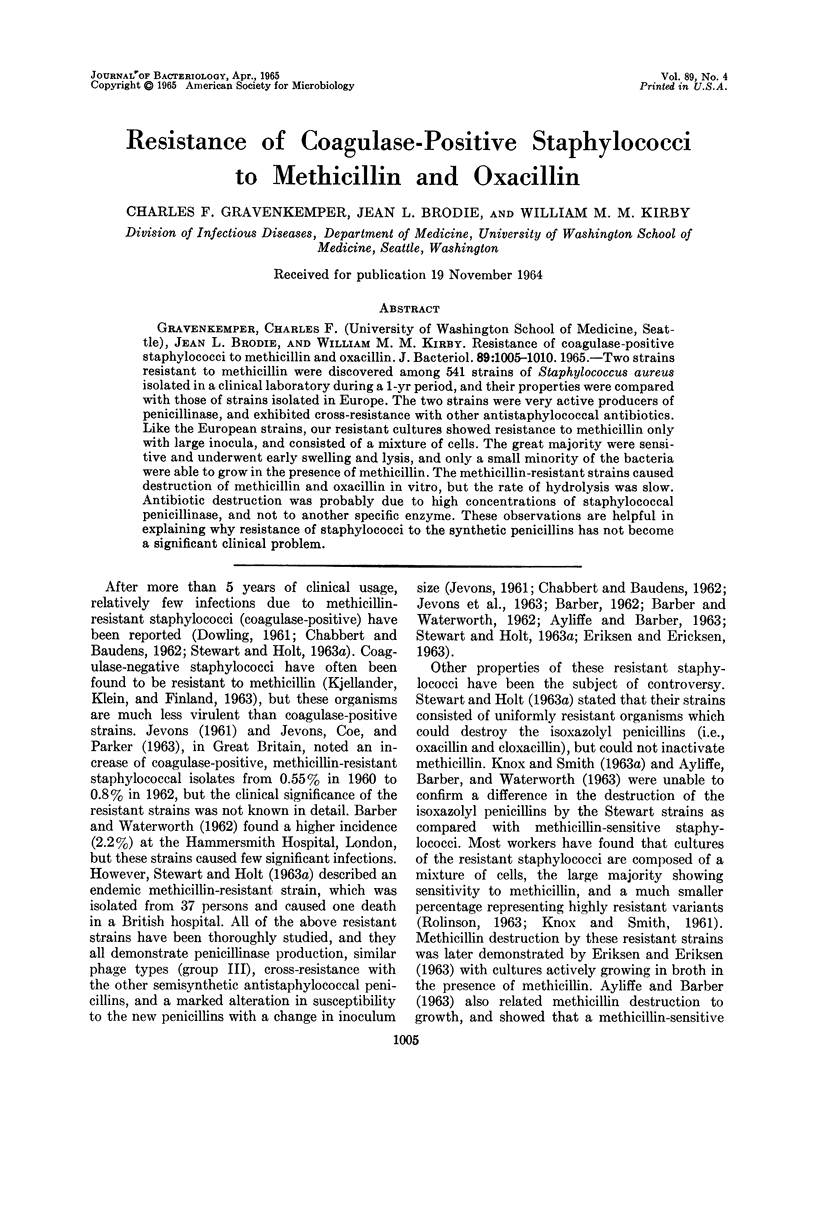Abstract
Gravenkemper, Charles F. (University of Washington School of Medicine, Seattle), Jean L. Brodie, and William M. M. Kirby. Resistance of coagulase-positive staphylococci to methicillin and oxacillin. J. Bacteriol. 89:1005–1010. 1965.—Two strains resistant to methicillin were discovered among 541 strains of Staphylococcus aureus isolated in a clinical laboratory during a 1-yr period, and their properties were compared with those of strains isolated in Europe. The two strains were very active producers of penicillinase, and exhibited cross-resistance with other antistaphylococcal antibiotics. Like the European strains, our resistant cultures showed resistance to methicillin only with large inocula, and consisted of a mixture of cells. The great majority were sensitive and underwent early swelling and lysis, and only a small minority of the bacteria were able to grow in the presence of methicillin. The methicillin-resistant strains caused destruction of methicillin and oxacillin in vitro, but the rate of hydrolysis was slow. Antibiotic destruction was probably due to high concentrations of staphylococcal penicillinase, and not to another specific enzyme. These observations are helpful in explaining why resistance of staphylococci to the synthetic penicillins has not become a significant clinical problem.
Full text
PDF





Selected References
These references are in PubMed. This may not be the complete list of references from this article.
- AYLIFFE G. A., BARBER M. Inactivation of benzylpenicillin and methicillin by hospital staphylococci. Br Med J. 1963 Jul 27;2(5351):202–205. doi: 10.1136/bmj.2.5351.202. [DOI] [PMC free article] [PubMed] [Google Scholar]
- BARBER M., WATERWORTH P. M. Antibacterial activity of the penicillins. Br Med J. 1962 Apr 28;1(5286):1159–1164. doi: 10.1136/bmj.1.5286.1159. [DOI] [PMC free article] [PubMed] [Google Scholar]
- BAUER A. W., PERRY D. M., KIRBY W. M. Single-disk antibiotic-sensitivity testing of staphylococci; an analysis of technique and results. AMA Arch Intern Med. 1959 Aug;104(2):208–216. doi: 10.1001/archinte.1959.00270080034004. [DOI] [PubMed] [Google Scholar]
- CHABBERT Y. A., BAUDENS J. G. [Staphylococcus strains naturally resistant to methicillin and 5-methyl-3-phenyl-4-iso-oxazolyl-penicillin]. Ann Inst Pasteur (Paris) 1962 Aug;103:222–230. [PubMed] [Google Scholar]
- DOWLING H. F. The newer penicillins. Clin Pharmacol Ther. 1961 Sep-Oct;2:572–580. doi: 10.1002/cpt196125572. [DOI] [PubMed] [Google Scholar]
- KJELLANDER J. O., KLEIN J. O., FINLAND M. IN VITRO ACTIVITY OF PENICILLINS AGAINST STAPHYLOCOCCUS ALBUS. Proc Soc Exp Biol Med. 1963 Aug-Sep;113:1023–1031. doi: 10.3181/00379727-113-28563. [DOI] [PubMed] [Google Scholar]
- KNOX R., SMITH J. T. Stability of methiciilin and cloxacillin to staphylococcal penicillinase. Br Med J. 1963 Jul 27;2(5351):205–207. doi: 10.1136/bmj.2.5351.205. [DOI] [PMC free article] [PubMed] [Google Scholar]
- KNOX R., SMITH J. T. The nature of penicillin resistance in staphylococci. Lancet. 1961 Sep 2;2(7201):520–522. doi: 10.1016/s0140-6736(61)92958-0. [DOI] [PubMed] [Google Scholar]
- SIDELL S., BURDICK R. E., BRODIE J., BULGER R. J., KIRBY W. M. New antistaphylococcal antibiotics. Comparative in vitro and in vivo activity of cephalothin, nafcillin, cloxacillin, oxacillin, and methicillin. Arch Intern Med. 1963 Jul;112:21–28. doi: 10.1001/archinte.1963.03860010067005. [DOI] [PubMed] [Google Scholar]
- SIMON H. J., RANTZ L. A. The newer penicillins. I. Bacteriological and clinical pharmacological investigations with methicillin and oxacillin. Ann Intern Med. 1962 Sep;57:335–343. doi: 10.7326/0003-4819-57-3-335. [DOI] [PubMed] [Google Scholar]
- STEWART G. T., HOLT R. J. Evolutio of natural resistance to the newer penicillins. Br Med J. 1963 Feb 2;1(5326):308–311. doi: 10.1136/bmj.1.5326.308. [DOI] [PMC free article] [PubMed] [Google Scholar]
- SUTHERLAND R., ROLINSON G. N. CHARACTERISTICS OF METHICILLIN-RESISTANT STAPHYLOCOCCI. J Bacteriol. 1964 Apr;87:887–899. doi: 10.1128/jb.87.4.887-899.1964. [DOI] [PMC free article] [PubMed] [Google Scholar]
- WALLMARK G. The production of penicillinase in Staphylococcus aureus pyogenes and its relation to penicillin resistance. Acta Pathol Microbiol Scand. 1954;34(2):182–190. doi: 10.1111/j.1699-0463.1954.tb00815.x. [DOI] [PubMed] [Google Scholar]
- WILKINSON J. F. Diabetes mellitus and pernicious anaemia. Br Med J. 1963 Mar 9;1(5331):676–677. doi: 10.1136/bmj.1.5331.676-a. [DOI] [PMC free article] [PubMed] [Google Scholar]


